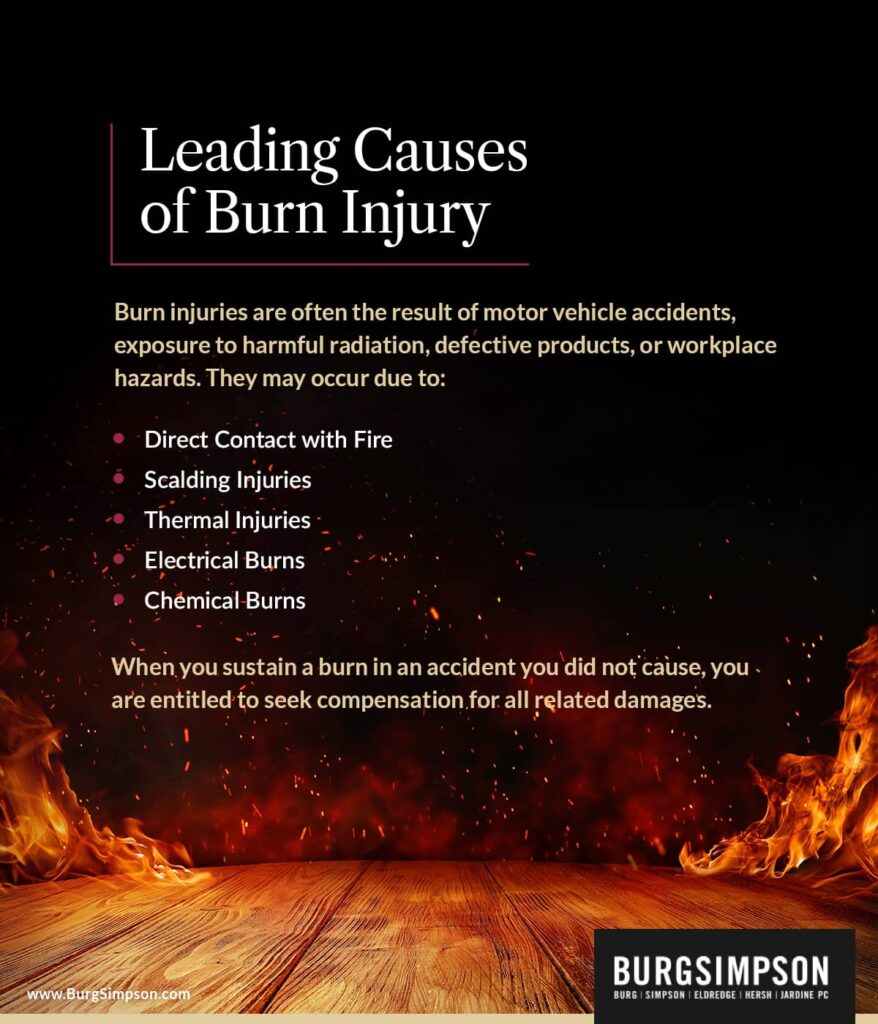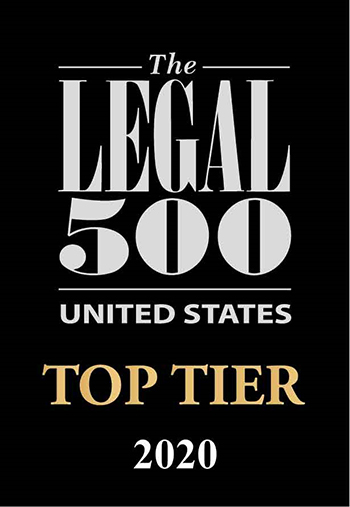Burn Injury Attorneys Serving the Denver Metro Area & All of Colorado
The Denver burn injury lawyers at Burg Simpson Law Firm understand how serious and life-altering a severe burn can be. We are here to assess the ways your injury has impacted your life, accurately calculate your damages, and assist you in seeking fair and full compensation.
If you have been injured or a loved one has died due to a serious burn injury, Burg Simpson can help. Experienced, thorough, and effective, our burn injury lawyers welcome the opportunity to meet with you, listen to your story, and provide straightforward advice on how best to proceed with your case.
To schedule your FREE and confidential consultation at our Denver office, call Burg Simpson at 303-792-5595 today. Our burn injury lawyers serve the Denver Metro area, surrounding Front Range communities, and all of Colorado.
The Six Degrees of Burn Injury
Burn injuries are classified by degree, each with its own set of characteristics and potential complications. The degree of burn injury suffered will dictate both its course of treatment and long-term impacts on your life.
The six degrees of burn injury are:
First-Degree Burns
First-degree burns impact the epidermis (surface of the skin) only. They often present as mild redness and can be accompanied by slight pain. The skin may feel warm to the touch, but these burns typically heal on their own without causing any lasting damage.
Second-Degree Burns
Second-degree burns extend into the dermis (deeper layers of the skin), and can cause the skin to become red, swollen, and blistered. Clear fluid may ooze from second-degree burns, and the pain can range from moderate to severe, depending on the extent of the injury.
Third-Degree Burns
Third-degree burns penetrate deeper into the skin, affecting the deeper layers of the dermis and underlying subcutaneous tissue. These burns often have a white or charred appearance and might feel firm to the touch. Due to damaged nerve endings, the burn area can sometimes be numb.
Fourth-Degree Burns
Fourth-degree burns are very serious. Extending beyond the skin, these burns can damage delicate tissue and fat and often appear blackened or charred. They require immediate and specialized medical attention.
Fifth-Degree Burns
Fifth-degree burns penetrate even deeper than fourth-degree burns. These extremely severe burns affect the muscle and may expose bone, leading to significant tissue damage. The affected area often appears charred and may be black or brown. The texture is typically hard or leathery due to the extensive destruction of tissues.
Sixth-Degree Burns
Sixth-degree burns are the most profound and severe of all burn categories. These burns char all layers of the skin and muscles, going beyond to damage bone as well. Sixth-degree burns are extremely rare and most often result in death.
While often life-altering, burns are seldom fatal. More than 96 percent of burn injury victims survive their injuries. Tragically, survivors often face chronic pain, itching, and heightened sensitivity in the burned areas. Non-fatal burn injuries are a leading cause of prolonged hospitalization, disfigurement, and permanent disability.
The Denver burn injury lawyers at Burg Simpson know how these injuries can impact every area of your life. We are here to help. Reach out for a FREE case review to learn more.
The Leading Causes of Burn Injury in Colorado
At Burg Simpson aw Firm, our burn injury attorneys have decades of combined experience assisting with cases involving burn injury from:
- Direct Contact with Fire. This remains a leading cause of burns, accounting for a significant percentage of hospital admissions.
- Scalding Injuries. Hot liquids and steam can cause severe burns, especially in children. Among these, hot tap water remains a major culprit.
- Thermal Injuries. These are caused by contact with hot solid objects, which can include everyday household items like curling irons, stovetops, or space heaters.
- Electrical Burns. This type of burn injury can result from contact with live electrical currents. Electrical burns can cause internal injuries that aren’t immediately visible.
- Chemical Burns. Also known as caustic burns, these result from skin contact with harmful chemicals, such as battery acid, bleach, or ammonia.
Burn injuries are often the result of motor vehicle accidents, exposure to harmful radiation, defective products, or workplace hazards. When you sustain a burn in an accident you did not cause, you are entitled to seek compensation for all related damages. Having an experienced and dedicated Denver burn injury lawyer on your side can help to ensure all of your concerns are addressed and maximum compensation is sought.

Treatments That Might Be Needed for a Serious Burn Injury
Moderate to severe burn injuries necessitate a multi-faceted approach to medical care. These include:
Debridement
This involves the removal of dead or damaged tissue, which can help prevent infections and pave the way for healthier tissue growth.
Skin Grafting
For more severe burns, healthy skin is taken from an uninjured area of the patient’s body and transferred to the burn site. This helps in faster wound healing and can improve functional and aesthetic outcomes.
Surgery
Beyond skin grafting, various surgical procedures can aid in the repair and reconstruction of damaged areas. These include:
- Contracture Release
- Scar Revision
- Reconstructive Surgery
Amputation
When a burn has caused damage to the point a limb or appendage cannot be salvaged or it poses a risk to the individual’s overall health, amputation might be deemed necessary. Following amputation, patients often require prosthetics and adaptive technologies, such as wheelchairs, to adapt.
Physical and Occupational Therapy
Even without surgery or amputation, after a severe burn injury, patients might face challenges in movement and daily tasks due to scar tissue contraction and reduced skin elasticity. Regular therapy helps in improving joint mobility, maintaining muscle strength, and assisting in relearning basic tasks to regain independence.
How Likely Is Recovery Following a Severe Burn Injury?
Burn injuries, especially third-, fourth-, and fifth-degree burns, can lead to permanent changes in the appearance and function of the affected area. Scarring is a common consequence, which can be discolored, raised, or contractured. Some patients might require reconstructive surgeries in the future to improve the function and appearance of the scarred areas.
Beyond the physical challenges, burn survivors may also face psychological hurdles. Post-traumatic stress disorder (PTSD), anxiety, and depression are common in burn victims. Tragically, a majority of burn injury survivors experience significant psychological distress for years after their accident.
When you are the victim of an accident, you should not be on the hook for its financial consequences. Nor should you be forced to deal with the long-term impacts of your injury without adequate compensation. The Denver burn injury lawyers at our firm have a long and proud history of helping individuals and families get justice. Reach out today for a complimentary consultation to learn how we can help.
Can I File a Lawsuit for a Burn Injury in Colorado?
When you sustain a burn injury in an accident in Colorado, you are entitled to seek compensation for all related damages—providing you are not fully responsible for the accident. Colorado follows a contributory negligence rule, meaning you can file a claim even if you played a role in the accident (see Colo. Rev. Stat. § 13-21-111). When damages are awarded in these cases, however, they are reduced by whatever percentage of fault can be attributed to the victim.
Establishing liability following a serious burn injury is often more complex than simply reviewing accident reports. Our Denver burn injury lawyers have the resources and experience necessary to thoroughly investigate the accident, identify all liable parties, and help you determine what your claim is really worth.
Colorado’s Burn Injury Statute of Limitations
In Colorado, burn injury victims have a limited window in which they can file a lawsuit. Generally, personal injury claims, including burn injuries, have a two-year statute of limitations. This means victims have two years from the date of the injury to initiate legal action. If, however, a burn injury is the result of a motor vehicle accident, the statute of limitations is extended to three years from the date the accident occurred (see Colo. Rev. Stat. § 13-80-102).
While you may have two to three years to file a claim, it is always best to speak with an experienced burn injury attorney as soon as possible. Swift action helps to preserve important evidence and may improve your chances of securing compensation. During your FREE consultation, we can discuss how we might approach your case to help protect your rights and assist you in securing every penny you are due.
Frequently Asked Questions
What Are Major Burn Injuries?
Third-degree burns are major injuries that need to be treated as a medical emergency. In addition to damaging multiple layers of the skin, a third-degree burn injury can severely damage tissue below the skin (including fat, muscle, nerves, and even bone).
If you or someone you love suffered third-degree burn injuries, you should seek medical attention as soon as possible. You should also speak to an attorney about your legal options if you believe negligence was a factor.
Burns that result in scarring or disfigurement, loss of mobility, and/or loss of function are considered catastrophic injuries. At Burg Simpson, catastrophic injury is the main focus of our firm.
Lawyers at Burg Simpson have unparalleled experience representing people who have suffered burns and other serious injuries through no fault of their own. Our firm has local clout—including in-depth knowledge of Colorado laws, the court system, etc.—and national strength. This combination allows us to provide superior representation and achieve consistent results for our clients.
Meet Our Attorneys
Can I Get Compensation for a Burn?
Your right to compensation for a burn injury depends on the circumstances. A burn injury lawyer can investigate to determine whether you have a cause for legal action.
In any personal injury case in Colorado, it must be shown that the party responsible was negligent and this negligence caused your injuries. Negligence can take many different forms. Identifying what caused the injury is crucial for establishing whether you are entitled to compensation.
There are multiple scenarios where compensable damages may be recovered for burn injuries. These include:
- Car Accidents
- Truck Accidents
- Motorcycle Accidents
- Fires & Other Incidents on Dangerous Premises
- Burns Caused by Defective Products
- Explosions
- Oil & Gas Accidents
- Construction Accidents
If you can prove that the negligence of another party was a factor in these or any other type of accident, our burn injury attorneys can pursue compensation on your behalf. You may be entitled to recover substantial damages for both current and future losses.
Tens of thousands of workers suffer burns on the job, with OSHA documenting 16,550 cases in a single year. If you or someone you love sustained a burn injury at work, you likely have a claim for workers’ compensation.
Finally, you and your family may be entitled to compensation for wrongful death if someone you love dies as a result of burn injuries. Severe burns in a fire or explosion may not be survivable, or a subsequent infection or other complication may prove fatal. Burg Simpson can fight for every dollar in damages you deserve so you and your family can heal.
How Much Compensation Can I Claim for a Burn Injury?
The only way to truly determine what your case is worth is to consult an attorney with extensive experience handling burn injury claims. Recoverable damages in a personal injury claim may include:
- All current medical expenses
- Medical expenses you will incur in the future
- Lost wages
- The loss of future income and earning capacity
- Personal property damage
- The cost of home and vehicle modifications, assistive devices, travel for medical appointments, etc.
- Pain and suffering
- Emotional distress
- Loss of the enjoyment of life
Most cases are settled without going to trial. Attorneys at Burg Simpson skillfully negotiate with defendants and insurance companies to obtain a burn injury settlement that fairly compensates clients for their losses.
If a settlement cannot be achieved, our burn injury lawyers can file a lawsuit on your behalf. Burg Simpson is a nationally renowned trial law firm. We regularly try cases in the courtroom, and our results speak for themselves.
More than $2 BILLION in verdicts, settlements, & judgments.
Can I Sue My Landlord for an Apartment Fire?
A fire at an apartment complex can leave multiple residents displaced and seriously injured. Fatalities are also a common occurrence in these disastrous situations. Burg Simpson is proud to help tenants pursue justice for burns and other injuries sustained in apartment fires.
Landlords and property management companies may be held liable if their negligence results in a fire that causes burn injuries. Potential grounds for a lawsuit include:
- Improperly installed and/or degraded electrical wiring
- Failure to inspect smoke detectors
- Lack of fire extinguishers on the property (or failure to replace expired ones)
- Building code violations
- Faulty gas lines
- Defective and poorly maintained appliances
- Cluttered hallways preventing evacuation
- Locked or blocked fire doors
- Unsafe fire escapes
Prompt and thorough investigation is required if you were injured in a fire at an apartment building, condominium, or other rental property. A burn injury lawyer can determine if a landlord or other party in control of the premises failed to exercise reasonable care in preventing fires.
Can I Sue If a Defective Product Causes a Burn?
We trust that the products in our homes and the vehicles we drive are safe. A failure or malfunction, however, can cause burn injuries. Defective products may also start fires that can consume a home or vehicle and result in serious injury.
Product liability is a major focus of our firm. We have extensive experience holding manufacturers and other companies accountable for faulty products that cause burns and other injuries. Sometimes a single product is defective. Other times, tens of thousands of the same product may suffer from the same dangerous defect. In the latter case, claims may be brought on an individual basis or as a class action.
You may be entitled to compensation for burn injuries caused by the following defective products:
- Electronic devices and household appliances
- Vehicles and automotive parts
- Water heaters and furnaces
- Power tools and heavy machinery
- Clothing with inadequate flame resistance
- Ovens and stoves
- Harmful chemicals
- And more
In Colorado, product liability actions may be brought on the following grounds: strict liability, negligence, breach of warranty, or misrepresentation. Burg Simpson has an extensive understanding of the laws concerning product liability litigation, and we will fight to maximize compensation for your injuries.
Are Burn Injuries Permanent?
The more severe the burn injury, the greater likelihood there is of permanent damage. Second-degree burns may leave scars if the dermis is severely impacted, but this is generally not the case. Third-degree burns, however, can result in damage that is both serious and permanent.
Victims of third-degree burns may suffer the following:
- Severe pain
- Permanent scarring of the injured area
- Disfiguring injuries; trauma to the head and face, neck, hands, arms, and other visible areas are particularly distressing
- Ongoing risk of infection
- Nerve damage; this can result in loss of sensation, loss of motor control, and/or nerve pain (neuralgia)
- Anhidrosis (dysfunction of the body’s ability to produce sweat, resulting in difficulties regulating body temperature)
- Tightening of the skin (known as contracture); often occurs when skin grafts are used to repair burned areas, resulting in restricted mobility
- Injuries to the lungs and airway—particularly common if heated gas or particles were inhaled
- Amputation—may be necessary if a limb is too badly damaged to save
Serious burns also carry a high psychological and emotional cost. Approximately 30% of individuals who suffer severe burn injuries develop post-traumatic stress disorder. Many others struggle with feelings of depression, anxiety, shame, and more.
It is critical to account for all of the ways a burn injury has impacted your life, to-date, as well as any ongoing or permanent effects. A burn injury lawyer at Burg Simpson can evaluate your current and future damages and prepare a strong case on your behalf.
Good Lawyers. Changing Lives.®
Why Choose Burg Simpson
Do I Need a Burn Injury Lawyer?
Burns should always be taken seriously. If you require professional medical care for a burn injury, your focus should be on getting better. A burn injury attorney can take action on your behalf to preserve your legal rights and make a claim for compensation.
Steps an experienced lawyer can handle for you include:
- Investigating the cause of the accident and your injuries
- Collecting evidence of negligence or wrongdoing
- Ensuring that your medical records fully reflect the severity of the burns, including any limitations or disability
- Consulting medical experts to determine your prognosis
- Hiring other expert witnesses to aid in the case, such as accident reconstructionists, experts in your occupation, etc.
- Evaluating your damages and calculating the full compensation you are due
- Filing a claim or claims with all applicable insurance companies
- Negotiating with the insurance companies to obtain a favorable settlement
- Moving forward with litigation (e.g., filing a lawsuit) if negotiations do not progress
- Presenting your case at trial (if necessary)
Recovery from burn injuries can be lengthy and intensive. You should not have to concern yourself with exercising your legal rights and pursuing compensation when your health, your well-being, and your finances have all been dramatically altered.
With more than 45 years of experience advocating for the wrongfully injured, Burg Simpson can provide the support and guidance you need and the aggressive representation you deserve in the aftermath of a burn injury. Our lawyers have earned a reputation as elite litigators and exceptional trial lawyers. We serve clients throughout the Denver metro area, all of Colorado, and nationwide.
Contact us for a FREE and confidential case review.
What Types of Compensation Can I Seek Through Legal Action?
Depending on the specifics of your case, the Denver burn injury lawyers at Burg Simpson can help you seek compensation for damages including:
- Current and Ongoing Medical Expenses
- Lost Wages and Diminished Earning Capacity
- Home Modifications and Adaptive Technologies
- Emotional and Physical Pain and Suffering
If personal property (like clothing, jewelry, or a vehicle) was damaged or destroyed in the incident that caused the burn, victims can seek compensation for the repair or replacement of those items as well.
It is important to note that there is a cap on non-economic damages in Colorado. While this amount increases with inflation, the state still imposes limits on how much victims of burn injury can seek for physical pain, loss of consortium, forced changes to lifestyle, emotional distress, and similarly non-quantifiable damages.
Can I Be Awarded Punitive Damages in a Colorado Burn Injury Case?
Punitive damages are intended to punish egregious, wanton, or intentionally harmful behavior. They are seldom awarded in Colorado burn injury claims. When awarded, they are capped at the total amount of compensatory damages.
During your FREE case evaluation, one of our burn injury lawyers will carefully review your claim to help you understand the different types of damages that may be available.
How a Burn Injury Lawyer Can Help
Seeking compensation following a burn injury can be daunting. Insurance companies are likely to spring into quick action to try and get you to settle. Unfortunately, the offers from insurance companies are often inadequate—particularly when the long-term consequences of burn injury are considered. Having a burn injury attorney on your side can help to ensure you do not accept less than you are due.
A burn injury lawyer will:
- Evaluate Accident Reports
- Collect Necessary Evidence
- Interview Witnesses
- Review Medical Records
- Determine the Value of Your Claim
- Fight for the Total Compensation You Deserve
Most burn injury claims are settled before they go to trial, but this is not always the case. When selecting a burn injury attorney, be sure to choose one experience both in negotiations and litigation. Having a proven trial lawyer on your side is essential when cases proceed to the courtroom.
Why Choose Burg Simpson?
When you sustain a serious injury, choosing the right legal representation is key to obtaining the best results. As one of America’s 25 Most Influential Law Firms, Burg Simpson knows the value the right legal team can bring to these cases. With over 45 years of experience, our personal injury lawyers have secured more than $2 billion in verdicts and settlements for our clients.
Good Lawyers. Changing Lives®
Specializing in various personal injury cases, Burg Simpson’s team of trial lawyers, paraprofessionals, and experts leverage their vast knowledge and skills to build rock-solid cases and fight for maximum compensation. When you choose us, you can expect honesty, compassion, and endless support. We will fight tirelessly to ensure your rights and interests are protected throughout the legal process.
Contact Our Denver Burn Injury Lawyers for a FREE Consultation
If you or a loved one has suffered a burn injury due to someone else’s negligence, contact Burg Simpson online or call us at 303-792-5595 to schedule your FREE and confidential case review right away. Our burn injury attorneys serve Fort Collins, Colorado Springs, Pueblo, and all of Colorado from our offices in Denver.





